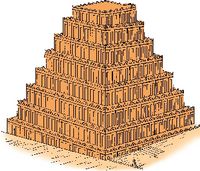Climbing the Ziggurat: On Sid Meier's Civilization
In this my first article I actually try to express my fascination towards the Civilization game series. It is brief hommage to a game I keep playing since more than a decade.

I have been always fascinated by the simplicity of the game cycle in the Civilization series. But what fascinates me even more is the way in which the cycle is transformed into a spiral. This is achieved through the scientific research feature of the game and the new, more powerful units that can be utilized as the result of completed research. What seems to be a merely flat or horizontal iteration of game mechanics, now gains height -or a vertical dimension- and puts the player into a more complex cycle: The illusion we experience is progress. Expansion, or the spatial element of the game, is connected with or placed into a certain mode of temporality, allowing the players to view the game as a story of progress. We have something like a plot and a dramatic curve. Story and history become part of the game, and set up a massive conflict: to progress faster than all others in order to survive. Together with all other features of the game we find ourselves in an environment that challenges us with dozens of decisions and actions in order to achieve our goal.
The Ziggurat or the Progress of Progress
Progress (the combination of the basic game cycle and and the technology-tree) in the Civilization games is like climbing the helezoic ramp of a ziggurat (and we even might consider the Tower of Babylon used in the game's intro-video as a metaphor of the game). It does not only address the climbing, but also tells us something about the importance of the gained height while climbing: The cycles at the bottom require to walk longer to complete them. The higher you climb, the shorter the cycle becomes, the less effort it requires.
However this ziggurat is yet growing itself. It continuously aims to reach the sky, so you try to gain height on a building that itself gets taller and taller. So what counts is the proportion of your acceleration not just to that of your opponents but also to that of the acceleration (growth rate) of the ziggurat. This marks the character of the competition in the game: It's about gaining acceleration in and against a world that itself accelerates to a certain extend.
As in the early stages of the ziggurat's growth you are at the bottom of the building, the radius of the cycles will be big; hence, being ahead of the opponents is not an advantage as such, as for the chasers, time and space is yet enough to catch the leader. The gained acceleration and its relation to the growth rate of the ziggurat has not yet translated clearly into a competitive advantage. But as you climb the building (while your relative acceleration materializes in the game's world) the cycles become more and more narrow, so for the chasers, both space and time to catch the leader becomes tight. In other words, for the one who leads, advantage gets more and more advantageous.
Leading is not just the purpose, it is the instrument to further lead. In order to lead in the future, you have to lead now. We have a winning strategy then: Lead everything!
Was this article useful? What do you think about Sid Meier and the Civilization series? Please leave a comment!
_____
Ziggurat illustration from The Eolia Campaign Homepage
Labels: Civilization, Sid Meier, video games


0 Comments:
Post a Comment
<< Home